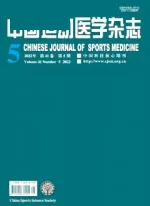前交叉韧带胫骨止点的解剖学研究进展
丁杰 李方祥 周敬滨 李永磊
1 上海体育学院(上海 200438) 2 国家体育总局运动医学研究所
前交叉韧带(ACL)重建过程中,骨道定位极其重要。以往的手术为了避免ACL与髁间窝顶撞击,胫骨骨道定位稍靠后[1,2],这样就做不到ACL的解剖重建,势必造成膝关节结构与功能异常,因此,熟悉ACL止点大小与解剖定位非常重要。股骨止点的骨性解剖标志研究较为明确——住院医师嵴和分叉嵴[3,4];胫骨止点的解剖标志较为复杂,尚无统一定论。本文主要就胫骨止点的大小以及解剖标志相关研究做一综述。
1 ACL胫骨止点解剖标志
ACL胫骨止点位于胫骨平台中央,其解剖标志主要分为骨性标志和软组织标志。关于胫骨止点的解剖标志,以往的研究并不完全相同。主要骨性标志有髁间隆起[5,6]、髁间窝顶[2]、“over-the-back”缘[6];主要软组织标志有ACL残端、外侧半月板[5,7]、后交叉韧带(PCL)[6,8-13]、膝横韧带[14]等。
1.1 髁间窝顶
Howell等[2]研究报道,膝关节处于最大过伸位时,ACL与髁间窝顶几乎处于平行的位置,因此可将髁间窝顶作为ACL的解剖标志。采用“三点法”钻取胫骨骨道,需要过伸膝关节,引导器尖置于外侧髁间隆起,引导器折弯处固定于髁间窝顶,引导器臂固定于髁间窝滑车凹处,然后在髁间窝顶下方4~5 mm,平行于髁间窝顶钻取骨道,这样可以避免发生移植腱与髁间窝顶的撞击,导致重建失败。
1.2 胫骨髁间隆起
Siebold等[5]认为ACL的胫骨止点近似于一个正方形,其四个边分别为:胫骨内侧髁间隆起前内缘(AMR);胫骨外侧髁间隆起前外缘(ALR);ACL前内束(AM束)最前缘(ABAM);外侧半月板止点。通过测量得出如下结果:AM束距离AMR(3±1)mm,位于ABAM后方约(5±1)mm;ACL后外束(PL束)距离ALR约(2±1)mm,位于ABAM后方约(6±2)mm。
Ferretti等[12]研究显示,AM束中点位于内侧髁间隆起前方(8.6±1.0)mm,PL束中点位于内侧髁间隆起前方(1.4±0.7)mm,且髁间隆起在术中很容易发现,故可作为解剖标志。
Edwards等[6]认为内侧髁间隆起外侧面尤为重要,AM束距离此处(5±1)mm,PL束距离此处(4±1)mm。由于髁间隆起在术中较容易发现,且是一种骨性标志,故其是一个重要的解剖标志。
有研究[15]通过内外侧髁间隆起的距离和PCL前缘来确定ACL中点的位置。ACL中点位于PCL前缘15 mm,从内侧到外侧髁间隆起的2/5髁间棘处;AM束中点位于PCL前缘20 mm,从内侧到外侧髁间隆起的1/4髁间棘处;PL束位于PCL前缘12 mm,从内侧到外侧髁间隆起的1/2髁间棘处。
1.3 “over-the-back”缘[ 66]
“over-the-back”缘是胫骨平台向后倾斜最高处的一个横向的棘状缘,即PCL胫骨止点前缘。Edwards等认为PCL稍有变异,此缘是一骨性标记,故较稳定,可以作为定位的标记。测量得出ACL胫骨止点的中点位于此缘前方(15±2)mm;AM束距离此缘(17±2)mm;PL束距离此缘(10±1)mm。
1.4 PCL止点前缘
以PCL作为定位标志的研究较多,也是临床中使用较多的,很多研究[6,8-13]均使用PCL止点前缘作为手术重建时的解剖标志。Purnell等[9]对8个膝关节尸体标本,通过三维CT进行研究,结果显示,ACL后缘距离PCL前缘约(16.5±2.1)mm。Cuomo等[11]研究显示,ACL的胫骨止点前缘距离PCL前缘(22±3)mm,胫骨止点后缘距离PCL前缘(6±2)mm左右。以往的研究结果并不完全相同,也可能与测试方法以及受试者的年龄相差较大有关。
虽然很多研究显示PCL是重要的解剖标志,但有的研究[2,3,5]认为其不能作为ACL重建时的定位标志,主要原因有以下三方面:首先,PCL是一种软组织,ACL损伤后,长期的关节不稳也会导致PCL松弛,从而定位不准;其次,PCL表面有滑膜组织,并不能真实反映ACL的位置;最后,PCL若同时损伤,就不能作为止点标志。
1.5 外侧半月板
外侧半月板也是一个重要的解剖标志。Zantop等[7]在20具尸体标本上研究ACL与外侧半月板前角的解剖关系,结果显示AM束中心位于外侧半月板前角的后方约(2.7±0.5)mm,内侧(5.2±0.7)mm;PL束中心位于外侧半月板前角后方约(11.2±1.2)mm,内侧(4.1±0.6)mm。Ferretti等[3]的研究也发现ACL与外侧半月板的关系。
Siebold等[5]对50个膝关节尸体进行解剖,结果显示ACL与外侧半月板后角存在一定关系,PL束中点位于外侧半月板后角前方约5 mm处。
关于外侧半月板,无论是前角还是后角,均与ACL存在一定的位置关系,可以采用外侧半月板作为定位标志,但其尚存一定的弊端:首先,对于外侧半月板损伤患者或者曾行外侧半月板修整术或切除术的患者,就不能正确显示其与ACL的正常解剖关系;其次,对于外侧盘状半月板患者,若出现ACL损伤,外侧半月板就不能作为定位标志。另外,半月板是一种软组织结构,有研究认为半月板不能作为定位标志。因此,采用外侧半月板作为定位标志也是有选择性的。
1.6 膝横韧带
有研究[3]称膝横韧带也是一个重要的解剖标志。膝横韧带起自内侧半月板前角或前缘,横行向外止于外侧半月板前角,尸体解剖中发现该韧带的出现率为80%。Ferretti等[3]的研究结果示ACL的中点位于膝横韧带后方(9.1±1.5)mm;AM束位于膝横韧带后方(4.6±0.7)mm。该韧带也是前交叉韧带的一个重要解剖标志,但是由于出现率并不是100%,并且是一种软组织,故此,在定位标记方面也受到一定的限制。
1.7 胫骨平台
还有研究用胫骨平台作为解剖定位的标记[6],测量止点中心至胫骨内外侧髁的最前方连线和最后方连线的距离。AM束中点距离胫骨内外侧髁最前方连线(12±2)mm,距离最后方连线(37±3)mm;PL束中点距离胫骨内外侧髁最前方连线(21±3)mm,距离最后方连线(28±3)mm。虽然在尸体标本上可以测出这两个距离,但在关节镜下测量其完整的长度与宽度较难,但不排除今后在计算机辅助下采用胫骨平台内、外侧距离以及前后距离作为重要的解剖标志。
ACL胫骨止点位置主要通过影像学检查确定。以往的研究主要通过X线侧位片和3-D CT来测量其具体位置。在X线侧位片上胫骨止点位置主要采用两条“前后方向的基线”来测量,一条是平行于内侧胫骨平台的线(Amis and Jakob法)[1],另一条是垂直于胫骨长轴的线(Stäubli and Rauschning法)[16]。
Kasten等[17]研究显示,AM束中点位于35%±4%处,PL束中点位于48%±4%处;Doi等[18]研究显示,AM束中点位于34.6%±4.3%处,PL束中点位于38.5%±4.3%处;Colombet等[12]研究显示,AM束中点位于36%±3.8%处,PL束中点位于52%±3.4%处。以上3个研究主要采用Amis and Jakob法测量。Iriuchishima等[8]研究显示,AM束中点位于31%±3%处,PL束中点位于50%±3%处;Zantop[7]研究显示,AM束中点位于30%处,PL束中点位于44%处。以上两个研究主要采用Stäubli and Rauschning法测量。虽然测量方式不同,但AM束的中点均在1/3处,而PL束主要位于40%~50%处。
采用3-D CT主要测量胫骨止点位于胫骨平台的前后(AP)和内外(ML)位置,用来明确AM束、PL束的位置。Lorenz等[19]研究显示,AP位AM束位于41%±3%,PL束位于52%±3%;ML位AM束位于48%±3%,PL束位于50%±3%。Forsythe等[20]研究显示,AP位AM束位于25%±2.8%,PL束位于46.4%±3.7%;ML位AM束位于50.5%±4.2%,PL束位于52.4%±2.5%。虽然以上研究结果的AP位并无明显相似性,但ML位均在50%左右。
1.8 AACCLL残端
ACL胫骨止点在术中需要准确定位,尽可能恢复ACL的正常解剖位点。ACL残端作为非常重要的解剖标志,主要原因在于即使在很多慢性损伤患者中,AM束的最前缘以及PL束的最后缘在术中可以准确探查,但是其AM和PL两束的止点准确区分较困难,也是双束重建的一个弊端。Siebold等[5]建议,AM束骨道定位在ACL止点的前内区域,即AM骨道距离残端前缘2 mm左右,这样可以防止屈膝时与髁间窝撞击;PL束定位于残端的后外侧,可以防止损伤外侧半月板后角。这样使双束之间存在一个2 mm左右的骨桥,可以保证更好的骨腱愈合,并可以防止以后由于骨道扩张合并骨道风险。
上述几种解剖标志均各有利弊,并不存在哪一种解剖标志能够准确定位。ACL胫骨止点的定位不如股骨止点清晰,因此在手术中尽量多找几个标志,将胫骨止点定位准确,达到其解剖位置。
2 A CL胫骨止点形态及大小
多数人群ACL胫骨止点呈三角形或卵圆形[21]。ACL在胫骨呈一扇形散开,形成一个鸭足样区域,胫骨止点的面积较ACL中间部分以及股骨止点大。Harner等[22]采用尸体标本,研究胫骨止点的面积是股骨止点的120%;Kopf等[23]采用137例关节镜手术患者研究股骨止点的面积较胫骨止点大。以上研究结果的不同,可能是由于其样本以及研究方法不同所致。
对ACL胫骨止点大小的研究以往也较多,主要是通过尸体标本和关节镜下测量得出结果。但由于研究对象差异较大,结果也不尽相同。Ferretti等[3]通过尸体标本进行研究,结果显示ACL胫骨止点的总长度为(18.1±2.3)mm,总宽度为(10.7±1.9)mm;AM束的长度为(9.8±1.8)mm,宽度为(11.1±2.1)mm;PL束的长度为(8.7±2.3)mm,宽度为(7.9±2.0)mm。Siebold等[5]通过50例膝关节标本研究发现,ACL胫骨止点面积为(114±36)mm2,宽度为(10±2)mm,长度为(14±2)mm;AM束胫骨止点面积为(67±31)mm2,宽度为(5±1)mm,长度为(12±2)mm;PL束胫骨止点面积为(52±20)mm2,宽度为(4±1)mm,长度为(10±2)mm。研究还分别测量了男性和女性胫骨止点的大小,男性面积为(130±45)mm2,女性为(106±29)mm2,结果有统计学差异;宽度男性与女性相近,但长度女性小于男性,女性为(14±2)mm;男性为(15±2)mm。Han等[24]采用尸体标本和3D MR研究胫骨止点的大小。结果显示,尸体标本胫骨止点长度为(14±2)mm,宽度为(9±1)mm;3D MR测量结果胫骨止点长度为(14±3)mm,宽度为(8±1)mm,两种测量结果差异无统计学意义。也有研究[18]通过关节镜手术测量胫骨止点大小,结果显示AM束长度为(9.2±1.2)mm,宽度为(8.9±0.9)mm;PL束长度为(7.1±1.1)mm,宽度为(6.9±1.0)mm;ACL胫骨止点总长度为(16.5±2.0)mm。Dargel等[25]通过尸体解剖研究发现右膝胫骨止点面积为(114.6±44.93)mm2,而左膝胫骨止点面积为(121.6±49.12)mm2。研究结果显示左、右膝关节ACL胫骨止点面积大小并不相同。以上的研究结果相差较大,主要原因可能是测量方法和研究对象不同。
3 总结
前交叉韧带胫骨止点定位非常重要,只有明确胫骨止点距离各个解剖标志的距离才能准确定位,避免重建后的前交叉韧带与股骨髁间窝撞击,防止胫骨前移。
[1]Amis AA,Jakob RP.Anterior cruciate ligament graft positioning,tensioning and twisting.Knee Surg Sports Traumatol Arthrosc,1998,6(Suppl 1):s2-s12.
[2]Howell SM.Principles for placing the tibial tunnel and avoiding roof impingement during reconstruction of a torn anterior cruciate ligament.Knee Surg Sports Traumatol Arthrosc,1998,6 Suppl 1:S49-55.
[3]Ferretti M,Ekdahl M,Shen W,et al.Osseous landmarks of the femoral attachment of the anterior cruciate ligament:An anatomic study.Arthroscopy,2007,23(11):1218-1225.
[4]Fu FH,Jordan SS.The lateral intercondylar ridge--a key to anatomic anterior cruciate ligament reconstruction.J Bone Joint Surg Am,2007,89(10):2103-2104.
[5]Siebold R,Ellert T,Metz S,et al.Tibial insertions of the anteromedial and posterolateral bundles of the anterior cruciate ligament:Morphometry,arthroscopic landmarks,and orientation model for bone tunnel placement.Arthroscopy,2008,24(2):154-161.
[6]Edwards A,Bull AM,Amis AA.The attachments of the anteromedial and posterolateral fibre bundles of the anterior cruciate ligament:Part 1:Tibial attachment.Knee Surg Sports Traumatol Arthrosc,2007,15(12):1414-1421.
[7]Zantop T,Wellmann M,Fu FH,et al.Tunnel positioning of anteromedial and posterolateral bundles in anatomic anterior cruciate ligament reconstruction:Anatomic and radiographic findings.Am J Sports Med,2008,36(1):65-72.
[8]Iriuchishima T,Ingham SJ,Tajima G,et al.Evaluation of the tunnel placement in the anatomical double-bundle acl reconstruction:A cadaver study.Knee Surg Sports Traumatol Arthrosc,2010,18(9):1226-1231.
[9]Purnell ML,Larson AI,Clancy W.Anterior cruciate ligament insertions on the tibia and femur and their relationships to critical bony landmarks using high-resolution volume-rendering computed tomography.Am J Sports Med,2008,36(11):2083-2090.
[10]Heming JF,Rand J,Steiner ME.Anatomical limitations of transtibial drilling in anterior cruciate ligament reconstruction.Am J Sports Med,2007,35(10):1708-1715.
[11]Cuomo P,Edwards A,Giron F,et al.Validation of the 65 degrees howell guide for anterior cruciate ligament reconstruction.Arthroscopy,2006,22(1):70-75.
[12]Colombet P,Robinson J,Christel P,et al.Morphology of anterior cruciate ligament attachments for anatomic reconstruction:A cadaveric dissection and radiographic study.Arthroscopy,2006,22(9):984-992.
[13]Hutchinson MR,Bae TS.Reproducibility of anatomic tibial landmarks for anterior cruciateligament reconstructions.Am J Sports Med,2001,29(6):777-780.
[14]Ferretti M,Doca D,Ingham SM,et al.Bony and soft tissue landmarks of the acl tibial insertion site:An anatomical study.Knee Surg Sports Traumatol Arthrosc,2012,20(1):62-68.
[15]Hwang MD,Piefer JW,Lubowitz JH.Anterior cruciate ligament tibial footprint anatomy:Systematic review of the 21st century literature.Arthroscopy,2012,28(5):728-734.
[16]Stäubli HU ,Rauschning W.Tibial attachment area of the anterior cruciate ligament in the extended knee position.Anatomic and cryosections in vitro complemented by magnetic resonance arthrography in vivo.Knee Surg Sports Traumatol Arthrosc,1994,2:138-146.
[17]Kasten P,Szczodry M,Irrgang J,et al.What is the role of intra-operative fluoroscopic measurements to determine tibial tunnel placement in anatomical anterior cruciate ligament reconstruction?Knee Surg Sports Traumatol Arthrosc,2010,18(9):1169-1175.
[18]Doi M,Takahashi M,Abe M,et al.Lateral radiographic study of the tibial sagital insertions of the anteromedial and posterolateral bundles of human anterior cruciate ligament.Knee Surg Sports Traumatol Arthrosc,2009,17(4):347-351.
[19]Lorenz S,Elser F,Mitterer M,et al.Radiologic evaluation of the insertion sites of the 2 functional bundles of the anterior cruciate ligament using 3-dimensional computed tomography.Am J Sports Med,2009,37(12):2368-2376.
[20]Forsythe B,Kopf S,Wong AK,et al.The location of femoral and tibial tunnels in anatomic double-bundle anterior cruciate ligament reconstruction analyzed by three-dimensional computed tomography models.J Bone Joint Surg Am,2010,92(6):1418-1426.
[21]Petersen W,Zantop T.Anatomy of the anterior cruciate ligament with regard to its two bundles.Clinical orthopaedics and related research,2007,454:35-47.
[22]Harner CD,Baek GH,Vogrin TM,et al.Quantitative analysis of human cruciate ligament insertions.Arthroscopy,1999,15(7):741-749.
[23]Kopf S,Pombo MW,Szczodry M,et al.Size variability of the human anterior cruciate ligament insertion sites.Am J Sports Med,2011,39(1):108-113.
[24]Han Y,Kurzencwyg D,Hart A,et al.Measuring the anterior cruciate ligament's footprints by three-dimensional magnetic resonance imaging.Knee Surg Sports Traumatol Arthrosc,2012,20(5):986-995.
[25]Dargel J,Pohl P,Tzikaras P,et al.Morphometric side-toside differences in human cruciate ligament insertions.Surg Radiol Anat,2006,28(4):398-402.

